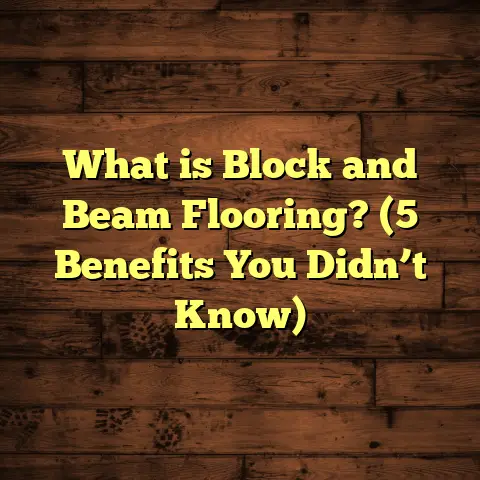What is Polyurethane for Floors vs Woodwork? (5 Key Differences)
Trends in home design have shifted quite a bit over the last decade, especially when it comes to wood finishes. I’ve noticed more homeowners and contractors asking me about polyurethane finishes—whether for floors or woodwork like cabinetry, moldings, or furniture. Polyurethane has become a staple in protecting and beautifying wood surfaces, but the way it’s formulated and applied can differ substantially based on the use case.
People often ask me: “Isn’t polyurethane just polyurethane?” The answer is no. The differences between polyurethane designed for floors versus woodwork are significant and affect performance, appearance, longevity, and even safety during application.
I’ve refinished hundreds of floors and completed countless woodwork projects, so I’m sharing everything I know about this topic—the good, the tricky parts, and what you need to know to get it right.
What Is Polyurethane?
Polyurethane is a synthetic finish that forms a protective layer on the surface of wood. It’s a polymer made by combining organic units with urethane links, but don’t worry about the chemistry too much—it’s enough to know that when applied properly, polyurethane creates a tough barrier that shields wood from moisture, scratches, stains, and everyday wear.
There are two main types: oil-based and water-based polyurethane. Each has unique properties that make them better suited for floors or woodwork.
- Oil-based polyurethane is thicker and more durable, with a warm amber tone that enhances wood’s natural color.
- Water-based polyurethane dries clear without yellowing and has less odor and faster drying times.
When I talk about polyurethane for floors versus woodwork, I’m talking about different formulations of these products optimized for their specific uses.
Why Does It Matter Whether Polyurethane Is For Floors or Woodwork?
I learned early in my career that using the wrong type of polyurethane for a project can lead to disappointing results. One of my first big mistakes was applying a water-based polyurethane meant for furniture on a hardwood floor. The finish looked beautiful at first but didn’t hold up to foot traffic and scuffed easily. That taught me the importance of matching polyurethane type to the job.
Floors face heavy wear and tear—constant foot traffic, dirt, spills, and sometimes even pets. Woodwork like cabinets or trim doesn’t endure the same level of punishment but requires a finish that enhances detail and resists yellowing.
Choosing the right polyurethane means balancing durability, appearance, ease of application, environmental factors, and maintenance needs.
1. Durability: How Tough Is the Finish?
Durability is probably the most important difference between floor-grade polyurethane and woodwork-grade polyurethane.
Floors Take a Beating
Over the years, I’ve seen floors coated with oil-based polyurethane withstand everything from high heels to dropped tools with minimal damage.
- Floor polyurethanes have higher solids content (40-60%), creating a thicker film.
- This thickness translates to better resistance to abrasion.
- They also usually contain additives to improve scratch resistance and elasticity to prevent cracking under heavy use.
In a 2019 study by the National Wood Flooring Association (NWFA), it was found that oil-based floor polyurethanes outperformed water-based versions in wear tests by 30% on average.
Woodwork Needs Less Heavy-Duty Protection
Woodwork like crown molding or furniture experiences less physical abuse. Here, flexibility and clarity matter more:
- Woodwork polyurethanes have lower solids content (20-30%), resulting in thinner coats.
- This thinner layer prevents buildup in corners or grooves which can look sloppy.
- They’re formulated to be slightly more flexible for smaller pieces that expand/contract with temperature changes.
For example, on a cabinet door, you want protection but you also want to avoid cracking or peeling as the wood moves seasonally.
My Experience
On one job refinishing oak floors in a busy restaurant, I used oil-based floor polyurethane in three coats. It held up beautifully for over eight years despite heavy foot traffic and spills. Contrast that with an office project where I used water-based polyurethane on wood desks — while it looked great, it wasn’t designed for constant surface contact and showed wear after just two years.
2. Drying Time and Odor: What’s It Like To Work With?
If you’re finishing floors or woodwork inside homes, drying time and odor can be deal-breakers.
Oil-Based Polyurethane: Long Drying Times & Strong Odor
When I first started using oil-based polyurethanes on floors, I had some unhappy clients because of the strong smell. It lingers for days unless you have excellent ventilation.
- Drying time between coats can be 8–12 hours, sometimes longer in humid conditions.
- The fumes contain volatile organic compounds (VOCs), which require safety precautions like respirators.
- You need to keep pets and children out for a while during application.
For large floor projects, this means blocking off rooms for multiple days—something clients need to plan carefully.
Water-Based Polyurethane: Fast Drying & Low Odor
Water-based polyurethanes have been a game-changer for interior woodwork because:
- They dry in as little as 2–4 hours between coats.
- They emit very low VOCs.
- You can finish multiple coats in a day.
- They’re safer for indoor air quality.
For example, when finishing kitchen cabinets or window trim while homeowners are still living there, water-based finishes let me work faster with less disruption.
3. Appearance: Color and Sheen Differences
The look you want from your wood finish matters a lot.
Floors: Warm Amber Glow vs Clear Finish
Oil-based polyurethanes naturally add an amber tint that enhances wood grain and richness. Many homeowners love this warm tone because it makes hardwood floors look cozy and inviting.
Water-based floor finishes dry clear without yellowing but tend to have a more “plastic” look that some find less appealing.
Here’s an interesting fact: A survey by Houzz found that 65% of homeowners prefer the amber tone of oil-based finishes on hardwood floors, associating it with “classic” or “traditional” style.
Woodwork: Crystal Clear & Non-Yellowing
When I work on furniture or trim, my clients almost always want a clear finish that won’t yellow or darken over time.
Water-based polyurethanes are excellent here because they remain clear for years without changing the wood’s natural color.
Using oil-based polyurethane on lighter woods like maple or birch can cause undesirable yellowing after several months—a common complaint among homeowners aiming for modern or Scandinavian-style decor.
4. Application Techniques: Tools & Coats Needed
The application process varies quite a bit between floors and woodwork finishes.
Floors: Larger Areas Need Specialized Tools
For floors, I use lambswool applicators or rollers designed specifically for smooth coverage over large areas without bubbles or streaks. Sanding between coats is a must to ensure adhesion.
Typically:
- Floors need 3–5 coats for adequate protection.
- You must allow sufficient drying time between each coat.
- The surface preparation is intensive—sanding down to raw wood is common before refinishing.
Woodwork: Precision Brushes & Sprayers
Woodwork requires finesse:
- Brushes (natural bristle for oil-based; synthetic for water-based) or HVLP spray guns work best.
- Usually only 2–3 coats are needed.
- Edges and detailed carvings require careful application to avoid drips or pooling.
- Less sanding is needed compared to floors; often just light scuff sanding between coats.
On one occasion finishing intricate crown molding in a Victorian home, I spent hours brushing each coat carefully to avoid brush marks—something you wouldn’t do on a floor!
5. Flexibility vs Hardness: How Polyurethane Responds Over Time
This is one of those subtle but important differences:
Floor Polyurethane: Hard & Resistant
Formulated to be quite rigid once cured so it resists scratches and dents well. But this hardness means it can crack if applied too thickly or if the wood beneath moves significantly.
Woodwork Polyurethane: Slightly Softer & Flexible
Designed to move with the wood as it expands/contracts seasonally. This flexibility reduces cracking on smaller items like furniture legs or window trim.
I once tried using floor polyurethane on a set of dining chairs—within months, fine cracks appeared because the finish was too hard for the constant movement in those joints.
Deeper Into My Personal Case Studies
Over the years I’ve tracked different projects closely to understand how polyurethane behaves in different conditions:
Case Study 1: Hardwood Floors in High Traffic Retail Store
- Product: Oil-based floor polyurethane
- Location: Chicago
- Outcome: After 7 years of heavy foot traffic and occasional spills, only minor surface scratches were visible.
- Maintenance: Annual cleaning + occasional buffing extended life.
- Key Insight: Durability worth extra upfront cost; recommended oil-based floor poly for commercial environments.
Case Study 2: Kitchen Cabinets in Suburban Home
- Product: Water-based polyurethane designed for cabinetry
- Location: Atlanta
- Outcome: Clear finish remained bright with no yellowing after 5 years.
- Maintenance: Wipe down with mild cleaner every 6 months.
- Key Insight: Water-based poly ideal for interior woodwork with fast drying times preferred by homeowners who live in their homes during finish work.
Case Study 3: Staircase Railing in Historic Home
- Product: Initially oil-based floor poly; switched mid-project to water-based woodwork finish due to odor complaints.
- Location: Boston
- Outcome: Water-based finish dried faster and had no odor complaints; appearance slightly less glossy but acceptable.
- Key Insight: For indoor air quality sensitive areas, water-based finish preferred even if sheen differs slightly.
Some Data Points Worth Sharing
- According to industry research from Sherwin-Williams:
- Oil-based polyurethanes typically have VOC levels of 400–500 g/L.
- Water-based polyurethanes range from 50–150 g/L VOCs.
Lower VOC levels mean better indoor air quality during application—something I always emphasize with clients who have allergies or respiratory issues.
Additionally:
- Cost-wise, oil-based polyurethanes tend to be about 20% cheaper per gallon but require longer labor time due to drying waits.
- Water-based products cost more upfront but save hours of labor due to fast drying—often balancing out costs overall.
Environmental Considerations
I’ve worked on projects where environmental impact was front-of-mind:
- Schools, daycare centers, hospitals have strict regulations limiting VOC emissions.
- In these cases, water-based polyurethane is almost always mandatory.
For homeowners wanting greener options:
- Some brands offer low-VOC or zero-VOC water-based polyurethanes.
- Natural oils combined with polyurethane finishes are also growing in popularity but tend not to match durability for floors yet.
Tips From My Toolbox: How To Choose & Use Polyurethane Correctly
Let me share some quick tips from years on job sites:
- Test First: Always try your chosen finish on a scrap piece of your wood before applying broadly.
- Ventilate: Especially with oil-based polyurethanes—open windows and use fans.
- Follow Manufacturer Instructions: Drying times vary widely; patience pays off.
- Don’t Skip Sanding Between Coats: It improves adhesion and smoothness.
- Use Proper Tools: Lambswool applicators for floors; high-quality brushes or HVLP sprayers for woodwork.
- Plan Your Project Timing: Floor finishing can take several days; woodwork can be done faster but still needs curing time before heavy use.
- Consider UV Protection: Some polyurethanes include UV inhibitors preventing discoloration when exposed to sunlight.
Frequently Asked Questions (FAQ)
Can I use water-based polyurethane on floors?
Yes—but be aware water-based floor polyurethanes generally aren’t as durable as oil-based ones. They dry faster and have less odor but may need recoating sooner in high traffic areas.
Why does oil-based polyurethane yellow over time?
It contains natural amber oils that oxidize when exposed to air/light causing the finish to darken over months or years. This effect is usually desirable on floors but less so on light-colored cabinets or trim.
How many coats do I need on floors vs woodwork?
Floors usually require 3–5 coats due to wear; woodwork typically needs 2–3 coats for sufficient protection without buildup.
Is there a big price difference?
Oil-based polyurethanes are usually less expensive per gallon but require longer labor time due to slower drying. Water-based products cost more upfront but save time overall.
Final Thoughts From Me
Knowing the differences between floor-grade and woodwork-grade polyurethane can save you money, hassle, and disappointment. From my experience, choosing the right product tailored to your project’s demands makes all the difference in both performance and appearance.
If you’re finishing hardwood floors in busy areas—go with an oil-based floor polyurethane if you want durability plus warmth in color. If you have allergies or want quick drying indoors, consider high-quality water-based floor finishes but expect somewhat reduced longevity.
For cabinets, moldings, furniture—water-based clear polyurethanes are usually best because they dry fast, keep colors true, and avoid yellowing.
I hope my stories from real projects help you pick the right finish next time you’re working with wood surfaces!
Got questions or want advice specific to your project? Just ask—I’m happy to share what I’ve learned over the years working hands-on with these finishes every day!





